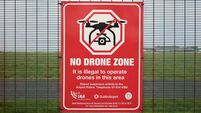Air Corps scandal still some way from touching down

While the stories broken by this newspaper since January have posed a myriad of questions for the State and the Defence Forces, the issues have one common controversy running throughout:
Have technicians within the Air Corps developed cancer, neurological problems, and other chronic conditions as a result of unnecessary exposure to toxic chemicals during their time at Casement Aerodrome?
THE COURT CASES
In January, this newspaper revealed how the State is facing at least six separate legal actions from former members of the Air Corps who claim that they have suffered serious illnesses as a result of chronic exposure to the chemicals they came in contact with while cleaning and servicing aircraft.
The first of these claims were submitted to the High Court in 2013, all are still pending an outcome.
The personal injury claims stated that the men suffer from a litany of neurological issues such as depression, anxiety, sleep disturbance and memory loss - all as a result of their time working for the Air Corps.
A toxico-pathologist quoted in documents submitted to the High Court stated that their exposure to chemicals not only caused existing medical complaints but also puts them at risk of “the possible onset of Alzheimer’s disease and a variety of cancers”.
Two of these men have since been diagnosed with cancer.
Those taking cases were based in adjoining workshops in Casement Aerodrome, in Baldonnel, Co Dublin. These workshops included the engine repair flight workshops and avionics squadrons workshops, which shared a building opposite the engineering wing hangar which housed the carpentry shop, sheet metal shop, hydraulic shop, and the spray paint shop.
In all the cases seen by the , the plaintiffs noticed unusual symptoms while based in Casement, and sought medical advice from the Air Corps doctor. All claim that at the time no connection was made between their complaints and their work with dangerous chemicals.
One noticed that the skin on his abdomen, groin and the upper parts of one of his legs changed colour and became lighter. He started suffering mood swings. It was only upon seeking more medical advice after leaving the Air Corps in the late 1990s that he was diagnosed with bi-polar disorder.
Another experienced nasal irritation, the loss of his sense of smell, dizziness, bloody diarrhoea, sores, and skin rash early on in his time with the Air Corps, had difficulty sleeping and suffered mood swings. He also suffered chronic headaches, short-term memory loss and fatigue, along with a yellowness of his skin and eyes.
A worker from the engine shop started suffering from fatigue, anxiety and difficulties concentrating. After leaving the Air Corps he presented to a doctor, complaining of constant vomiting and diarrhoea.
Like his colleagues, it was only upon seeking further medical help after leaving the Air Corps that this former staff member was told his complaints may have been caused by the duties he carried out in Baldonnel. In one of the cases, the worker now suffers stabbing pains, a numbness in his limbs and uncontrollable, profuse sweating.

In three cases seen by the , former Air Corps workers have been told that they are suffering organic encephalopathy — brain disorders — due to a chronic high dose exposure to organic solvents.
The Air Corps is accused of not training these staff members on how to handle harmful chemicals, neglecting to provide them with the protective equipment they needed to work with the substances, and failing in their duty of care by not properly investigating their medical complaints as they arose.
It is further claimed that a blind eye was turned to practical jokes using the chemicals — including “tubbing” which allegedly saw young members of the Defence Forces doused in substances used in the workshops by more senior colleagues, who were not aware of the hazards posed by the chemicals.
The State denies any responsibility for the men’s’ illnesses.
“No admission is made that the defendants exposed the plaintiff to dangerous chemicals or solvents whether on an ongoing basis or at all,” the State said in court documents.
“The defendants plead that if the plaintiff suffered any personal injury, loss or damage it was not caused by any act or omission on its part or was not a reasonably foreseeable consequence of any such act or omission,” the document continues.
“Furthermore, if the plaintiff suffered any personal injury, loss or damage it is said that this was due wholly or partly to his own negligence,” the State argued.
THE WHISTLEBLOWERS
Two years after the first case against the State was lodged in the High Court, the Department of Defence received an email.
It was November 2015, and the first of three whistleblowers who would make numerous submissions to the Government broke cover to make the first protected disclosure on the issue.
The whistleblower identified seven dangerous chemicals, some which are known to be cancer-causing and genetic-altering, and said that Air Corps staff were routinely working with these substances.
This first email warned then-defence minister Simon Coveney that the staff working with these chemicals were not being provided with Occupational Health Surveillance — something that would pick up, at an early stage, whether staff health is being affected by their exposure to chemicals during their work.
The whistleblower said such screening is required by law.

Weeks later, a second whistleblower made contact to claim that “at no point” during his Air Corps career was he ever offered health surveillance.
This man said he believes that the Air Corps was failing to issue personal protection equipment to all personnel exposed to harmful and toxic chemicals in their day to day working environment.
The whistleblower further stated that he believed that these conditions within the Air Corps can be linked to illnesses among serving and former Air Corps personnel.
“What has happened in the past and what is still happening regarding chemical health and safety in the Irish Army Air Corps is a grave scandal which I believe has seriously injured the health of a number of personnel,” the second whistleblower warned.
A third whistleblower came forward weeks later with similar complaints - and further alleged that he was being targeted within the Air Corps for raising his concerns.
In September 2016, the Department of Defence tasked former civil servant Christopher O’Toole with carrying out an independent review of the whistleblowers’ claims, and his report was sent to the whistleblowers in October for their observations.
Meanwhile, the third whistleblower, who almost two years ago warned he was being targeted for, was last month brought before a Medical Board facing a charge of alleged “chronic ineffectivity” due to anxiety and a “work-related industrial dispute”.
This was revealed in the , and led to Junior Defence Minister Paul Kehoe telling the Dáil that he will ensure the whistleblower receives the protections available under the law.
“I have recently written to the chief of staff restating my position that the individual concerned is afforded the full protection of the Protected Disclosure Act. I have made clear that no action should be taken that would impinge on his rights in accordance with protected disclosure legislation,” Mr Kehoe said.
THE HEALTH WATCHDOG INSPECTION — VINDICATION FOR THE WHISTLEBLOWERS
The whistleblowers also complained directly to the Health and Safety Authority, which prompted the watchdog to investigate - and its findings in October 2016 largely vindicated the claims the men had made to the Government.
The five-page HSA report was issued following inspections that took place in February, April and September 2016.
It found that the Air Corps needed to monitor its workers’ exposure to harmful substances, observe their health for the early detection of adverse changes, and give them the equipment they need to protect themselves against chemical exposure.
The report gave 13 recommendations, and warned that “Failure to comply with this advice and relevant legal requirements may result in further enforcement action including prosecution.” The more lengthy recommendations in the report related to the monitoring of employees’ health to ensure early detection of any illnesses.
“Health surveillance should be among the necessary measures to be considered for controlling identified chemical exposure risks,” the report stated.
“The putting in place of a programme to monitor employees’ actual exposure to particular hazardous substances is another measure that should be considered as part of the risk assessment process.”
Staff also need to be given the necessary equipment to protect themselves from chemical exposure, the HSA said.

“Adequate and appropriately specified Personal Protective Equipment (PPE), in particular protective gloves, eye protection and respirators for protection against chemical exposure, must be readily available to employees as required by relevant risk assessment findings,” the report warned.
The Air Corps was told that it needed to review its risk assessment process to address exposure by employees to hazardous substances, and ensure employees are informed and trained adequately.
The health and safety measures at Baldonnel need to be in accordance with “established good industry practices”, the report said.
“It is your responsibility to ensure the health and safety of employees and others, such as members of the public, who may be affected by the way you run your business,” the HSA Inspector said.
The Air Corps issued a two-page reply in which its Safety Officer said the Air Corps will comply with the workplace health and safety legislation, and that it is “fully committed to implementing the improved safety standards that protect workers from potential exposures to chemicals and will ensure risks are are low as reasonably practicable”.
The reply outlined an eight-phase improvement plan, with a target of December 2017 by which the Air Corp will have implemented each part of this plan.
It promised to introduce chemical awareness training for staff; to put in place more stringent controls for carcinogenic and mutagenic (CMR) chemicals; to make protective equipment available for staff and consider mobile extraction systems where practicable.
“Health Surveillance and Biological Monitoring will be considered and documented on the activity based risk assessments and the CMR additional risk assessment where necessary,” the Air Corps reply stated.
The HSA has since said it is satisfied with the implementations of its recommendations, and considers the case closed.
THE INTERNAL REPORT
Once the lawsuits were filed, the State Claims Agency got to work on determining what was going on in Casement Aerodrome.
Following the SCA’s request for information, the Air Corps went about producing a report. The Chemical Exposure Report (1994-2005) is with Junior Defence Minister Kehoe, who said he will not publish the document because it is legally privileged.
However earlier this year the revealed the contents of internal Air Corps documents that raised serious concerns about staff exposure to cancer-causing chemicals.
The report investigates the working environment in a since-demolished engine workshop building, and was written over two-and-a-half years before the Health and Safety Authority raised a number of concerns about conditions in Baldonnel.
In its summary on precautions taken with the Triklone N solvent, the report issued by the Air Corps’ Formation Safety Office asks “can the Defence Forces be found not to have done everything reasonably practicable?”.

Triklone N contains trichloroethylene, a known carcinogen, and is a vapour degreaser that was used to clean engine parts. The chemical has been at the centre of other exposure controversies in Defence Forces around the world.
The report said it found no records that show that personal protective equipment PPE was made available to staff, and no documentation to suggest that any training on the dangers of using Triklone N took place.
It said work areas were not segregated and doors to adjoining areas were left open - and that the staff tea room and meeting area were located in an adjoining area, raising the risk of their food being contaminated.
Furthermore, the report suggested the technicians’ clothes could have been contaminated as personnel lockers were located in the immediate area where the chemical was used.
The internal memo also warned that there was no evidence to suggest that the extractor fans in use in the workshop were adequate for ventilating the area - and further cautioned that a heater in the engine assembly area could have circulated contaminated air into other parts of the building - increasing the risk of chemical exposure.
The report concluded by asking if enough was done to protect staff from identified risks.
“The question posed should be: Was everything reasonably practicable done to ensure personals safety and health at the time?” The report stated the Air Corps discontinued the use of Triklone N in September 2007.
THE MISSING REPORTS - AND ALLEGATIONS OF A COVER-UP
Within weeks of the first revelations in the , the Dáil heard allegations of a cover-up within the Air Corps on the extent of the force’s knowledge of the chemical exposure issue.
“I have seen health and safety reports going back as far as 1995, all of which pointed specifically to the issues that were addressed in the Examiner newspaper,” Sinn Féin defence spokesman, Aengus Ó Snodaigh told the Dáil in February.
“So this is not a new issue, this is a cover-up because the military authorities in Casement Aerodrome did not take the required steps when it was highlighted to them that dangerous chemicals existed they didn’t take those steps,” Mr Ó Snodaigh claimed.
The documents in question were also examined by Fianna Fáil defence spokeswoman Lisa Chambers who wrote to the then-taoiseach Enda Kenny about the issue.
“It appears that health and safety concerns were known at the base for some time and there was a failure to act which may have unnecessarily and negatively impacted on the health of those working and serving at the base,” she advised.
She said the reports from 1995 and 1997, carried out by now-dissolved public body Forbairt, “appear to identify risks in the workplace around air quality and health and safety at work” and made “a number of recommendations were made surrounding use of and training around hazardous chemicals and use of respirators”.

The ’s attempts to locate these documents from the Air Corps and Department of Defence proved unsuccessful. Freedom of Information requests were refused because officials “cannot locate the records requested”.
In June, this newspaper revealed how Junior Minister Kehoe had received a new protected disclosure in which it was alleged that a named official ordered the shredding of documents. The subsequently reported that Mr Kehoe met with another whistleblower who made the same allegation, albeit without naming the official involved.
Despite these allegations, Mr Kehoe has said he has no intention of ordering an investigation into the reports’ disappearance - despite only being able to offer “speculative” explanations as to how they went missing.
“The military authorities have indicated that the Defence Forces have neither a hard copy record nor an electronic copy of the Forbairt Reports,” Mr Kehoe said in a reply to Mr Ó Snodaigh.
“The authorities have indicated that there are a range of potential causes for the loss of the reports such as the changeover of electronic recording systems in 2004 or that the reports were misplaced over time. However, this is purely speculative. It is not proposed to have an independent third party carry out an investigation into the reasons the Forbairt reports cannot be found,” he said.
Mr Kehoe has offered no explanation as to how the reports are circulating among opposition politicians when the Defence Forces and his Department have no copies of the documents.
THE INDEPENDENT REVIEW
Last October brought with it the long-awaited findings of Christopher O’Toole’s review of the whistleblowers’ claims. His report, however, added little clarity to the situation.
Opening his report, Mr O’Toole said he was “not in a position to consider the substances in use or any implications for human health arising from such use as these issues are outside my competence”.
“Having considered the allegations made by the three informants it is my view that a review of the kind envisaged by the terms of reference set out above is impractical and I, therefore, can only comment in general terms on the safety regime.”
Crucially, his 37-page report found no evidence that proved that the Air Corps complied with its health and safety obligations.
“A problem has arisen in relation to the issues raised by the three informants because appropriate records to demonstrate compliance are not readily available,” he revealed.
“I have no material which would provide a record of any assessment or procedures at the time relevant to the allegations made,” he said in reviewing of the whistleblower’s claims.
He went on to suggest that the pending court cases are an appropriate avenue to investigate the claims.

“In the absence of such records, proof of compliance is problematic and establishing the actual situation at the time in question would be a complex task requiring the gathering of evidence and probably taking oral testimony; in effect a forensic exercise which it is not possible for me to carry out,” he said.
This suggestion has been subsequently criticised by the whistleblowers, who say any out-of-court settlement would mean such a forensic exercise would never take place.
Even if the cases go ahead, the whistleblowers argue that these proceedings would be limited to the individual experiences of the plaintiffs, and will do nothing to address wider concerns for members of the Air Corps.
It would eventually emerge that Mr O’Toole’s review was completed without sight of a key document - the Air Corps’ own internal report into the matter.
Earlier this month Mr Kehoe told Mr Ó Snodaigh that the independent reviewer was not given a copy of the Chemical Exposure Report (1994-2005).
Mr Kehoe said it would not have been “appropriate” to give the report to Mr O’Toole.
“As the report is subject to legal privilege, it was not appropriate to make it available to the independent reviewer,” he said.
THE INTERNATIONAL PRECEDENTS
Claims that members of the Defence Forces have suffered ill-health due to their exposure to chemicals used to clean and service vehicles are not unique to Ireland, and there are a number of international precedents in this regard.
Earlier this month the New Zealand Herald published an investigation that found that “hundreds” of New Zealanders may have been affected by their exposure to a chemical in a wide range of workplaces.
The chemical at the centre of the Herald investigation is trichloroethylene — the same substance that was the subject of the Irish Air Corps report whose details were revealed by the .
In October the same newspaper reported that a New Zealand navy veteran won “a years-long battle for compensation after connecting his Parkinson’s disease with chemical exposure during his military service.”
Describing the development as a “potentially-landmark case”, the Herald reported that the ex-serviceman developed Parkinson’s, a condition attributed to his operational service on a Royal New Zealand Navy ship.
“During his naval career, he was exposed to toxic chemical solvents, including trichloroethylene, while degreasing and cleaning electronics,” the Herald reported.
It was reported that the Camp Lejeune cases in the US was considered a precedent in the New Zealand determination.
In 2012 then-US president Barack Obama signed the Janey Ensminger Act into law.
Named after a nine-year-old girl who died of Leukemia, the act provides medical care for people who may have been affected by the contamination of water at Marine Corps Base Camp Lejeune in California, where servicemen and women lived with their families.
Dozens of chemicals were found to have contaminated the water at the Camp - including trichloroethylene.

Meanwhile, in Australia, the government has paid tens of millions of dollars in compensation to former air force servicemen and women in recognition of the illnesses they suffered having worked with harmful chemicals.
While a compensation scheme was established for one select set of workers, there have been calls for it to be widened to include more workers who attribute their ill health and disability to the duties they carried out for the Royal Australian Air Force (RAAF).
The claims started with complaints from the RAAF’s “goop troop” — workers who performed maintenance on the fuel tanks of the F111 bombers, a task known as the “deseal reseal programme”.
The design of the aircraft required workers to crawl into its fuel tanks and use toxic chemicals for hours at a time in cramped conditions to fix leaks from the inside.
In 2000, the department of defence commissioned a board of inquiry to examine the health effects of the Air Force staff’s working conditions, following hundreds of complaints from veterans suffering cancer, depression, and other illnesses.
Last year, the findings of a health study were published.
It found that those involved in the deseal reseal programmes had 39% higher rates of cancer than a control group made up of members of the general population, and a 30% higher incidence rate than other Royal Australian Air Force personnel who were not exposed to the chemicals.
It also found that the F111 workers had a 27% lower mortality rate compared with non-exposed Air Force personnel. It has been suggested that the awareness of the chemical exposure issue has led to proper health screening and care for those affected, resulting in the early detection and treatment of illnesses compared to the general population.
In its 2010-2011 budget, the Australian government allocated A$55m (€38m) over five years towards a healthcare and compensation package for the former F-111 aircraft fuel tank maintenance workers.
However, findings from subsequent health studies have led to calls for a wider compensation scheme for those working with jet fuel and other chemicals within the Australian defence force.
THE POLITICAL REACTION
The revelations in the , and the Government’s handling of the ongoing scandal, has drawn criticism from opposition politicians who have called for a commission of enquiry into the issue.
Mr Ó Snodaigh has consistently raised issues relating to the ongoing scandal in the Dáil. He has previously said that the O’Toole report is, in one way, welcome, because it highlights the lack of documentation to show standards were met in the Air Corps.
“It does not, however, examine allegations made in the protected disclosures, that records which would have shed light on what was going on at Casement Aerodrome were deliberately destroyed,” he said.
“It is now time for the Government to act in the best interests of the Defence Forces and carry-out a full review of health and safety protocols at Casement Aerodrome over the last three decades, which must be thorough, transparent and with terms of reference that allow for an in-depth examination of how chemicals and other toxic materials were managed,” Mr Ó Snodaigh said.
His Fianna Fáil counterpart Lisa Chambers has also frequently raised the issue with the Junior Defence Minister. Her letter to then-taoiseach Enda Kenny earlier in the year sets out her position on the matter.
“Taoiseach, I believe we have to get to the bottom of this, it appears that health and safety concerns were known at the base for some time and there was a failure to act which may have unnecessarily and negatively impacted on the health of those working and serving at the base,” Ms Chambers wrote last February.
“If the State has failed in their duty to protect people in the course of their employment at Baldonnell then we need to identify those affected and ensure an adequate health care package is put in place for these people,” she said.

Her party leader Micheál Martin said the constraints put upon the independent investigation into the whistleblowers’ claims rendered the report on their claims ‘farcical’.
“The situation is far from satisfactory because with his opening comments the report’s author is essentially saying he cannot fulfill the terms of reference. From the Government’s point of view they established this review, they must have known the terms of reference could not be fulfilled.
"It’s farcical. It seems to me there are no records of compliance with health regulations, which is very, very serious because in their absence one has to conclude that the probability is they were not complied with,” Mr Martin said.
“The Government needs to establish a forensic examination into this. I don’t think it is acceptable to wait for court cases against the State to conclude as there is no guarantee these legal proceedings will establish what happened in the past.
"In the meantime the government needs to initiate a health assessment, similar to what was introduced by the Australian government, a baseline study of the personnel who worked in Baldonnel,” Mr Martin added.
Labour’s Brendan Howlin raised the issue in leaders’ questions last month, and asked how the Government plans to address the matters raised by the whistleblowers, and whether they will be protected for speaking out:
“Is it satisfied that the Defence Forces’ members who met the Minister of State, Deputy Paul Kehoe, to discuss these concerns are receiving the full protection warranted under the Protected Disclosures Act?”
“Has it considered the establishment of a commission of investigation to establish whether the health and safety management regime at Casement Aerodrome meets the standards of the day and whether the allegations have any credibility?”

The whistleblowers were invited to send their observations on the O’Toole report to Mr Kehoe. The government says this feedback will inform its decision as to what to do next.
It is now nearly five years since the first lawsuit was filed, and two years since the Department of Defence received the first protected disclosure on the Air Corps chemical exposure matter.
Former and current Air Corps staff, plaintiffs and whistleblowers, are hoping 2018 will be the year that progress is made in this long-running saga.













